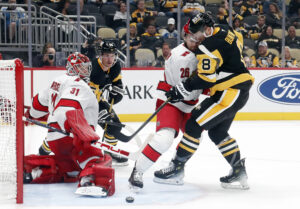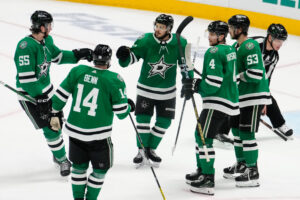Even as hockey leagues all over the world take a hiatus, the Last Word on Hockey team is still devoted to publishing quality content in the absence of live sports. Such begins a new series: the NHL Rivalry Breakdown.
Each article will take a look at two longtime rivals and break down how the rivalry came to be, how the teams stack up against each other currently, and how the matchup may look down the road. The first edition takes a look at two behemoths of the 1990s: the Dallas Stars and Colorado Avalanche.
NHL Rivalry: Dallas Stars and Colorado Avalanche
The Past
While both franchises have existed since before 1980, the rivalry only started when both Dallas and Colorado set up shop in their present homes. The Minnesota North Stars were part of the NHL’s 1967 expansion but moved south to the Lone Star State in 1993. The Quebec Nordiques franchise originated in the WHA beginning in 1972, but joined the NHL in 1979 and moved to Denver for the 1995-96 season.
Avalanche fans were granted immediate success, as their team won the Stanley Cup in their first season in Denver. It was the beginning of a dominant reign of terror in Colorado, as they made the playoffs every year from there on out until the 2006-07 season, and won eight straight division titles. They also rose to the top to lift Lord Stanley’s trophy in 2001.
Dallas didn’t have the success right off the bat that Colorado did in their new home, but they ended up making steady improvements until 1999, where they won the Stanley Cup for the first time in franchise history in a controversial series against the Buffalo Sabres. You can pinpoint that 1999 playoff run as when this rivalry truly started.
1999 Western Conference Final
The late 1990s were a great time for Western Conference hockey, as there were three true powerhouses in Colorado, Dallas, and the Detroit Red Wings. Colorado and Dallas met in the playoffs for the first time since moving to their new cities this year in the Western Conference Final. Dallas defeated the number eight seed Edmonton Oilers and number five seed St. Louis Blues to reach the third round, while Colorado bounced the number seven seed San Jose Sharks and number three seed Red Wings.
Both squads were incredibly talented, boasting many future Hall of Famers. For Dallas, that list included Mike Modano, Joe Nieuwendyk (the eventual Conn Smythe winner), Brett Hull, Sergei Zubov, Guy Carbonneau, and goalie Ed Belfour. Colorado boasted a strong one-two punch down the middle of Peter Forsberg and Joe Sakic and also had elite goaltending from Patrick Roy.
The series stretched seven games and included a Game 4 overtime winner from the Avalanche’s Chris Drury, but Dallas eventually prevailed in the seventh contest with a 4-1 win at home, propelling them to the Stanley Cup Finals. Mike Keane, Jamie Langenbrunner, and Jere Lehtinen all scored in that game. Overall in the playoffs, Dallas and Colorado’s players made up the top six skaters in terms of points and seven of the top eight. Mats Sundin was the only skater able to crack that list who was not on either team. It’s widely believed that even if Dallas had lost that series, Colorado would have gone on to win the Cup similarly. The quality of hockey on display in that series made it one for the ages and set up a friendly rivalry that still manifests itself today in a tight Central Division race, albeit on pause.
The Present
Dallas: Defensive Demons
Dallas’ goal-scoring struggles have been well-documented this season, but so has their defensive prowess. While they have a goal differential of +3, their offence is 28th in the league, having only potted 180 goals. The positive goal differential is explained by their stellar defence, however, as they’ve only allowed 177 goals which put them second in the entire NHL.
Their projected lineup when fully healthy reads as such:
Jamie Benn – Tyler Seguin – Alexander Radulov
Denis Gurianov – Roope Hintz – Joe Pavelski
Andrew Cogliano – Radek Faksa – Corey Perry
Mattias Janmark – Jason Dickinson – Blake Comeau
Miro Heiskanen – John Klingberg
Their first line reads out solidly, with two definite first-line calibre players in Benn and Radulov. They are complemented by a borderline elite centre in Seguin. The second line sees solid players in Hintz and Gurianov, who fit in well in the top-six. Add Pavelski, who’s struggled so far in Dallas but still has a place somewhere in the top two lines of most NHL teams.
The third line is where it starts to get tricky. While Faksa and Perry are okay for their roles, the lack of depth starts to show with the playing of Cogliano up on the third line. At his age, he’s much more suited for a fourth-line role and it’s shown this season. Janmark and Comeau are good fourth line plugs, and Dickinson is a great choice at the centre position. Their extra players are nothing to write home about, as players like Justin Dowling and Joel Kiviranta have made marginal contributions this season.
What Makes Them Demons?
Moving towards the defence, it becomes evident why they are the masters that they are. Heiskanen is a bonafide no. 1 defenceman on his own, certainly on his way to becoming elite. Klingberg also excels in a top pairing role. Both Oleksiak and Fedun have played quality hockey defensively this season, earning them their second-pairing roles shown here. Being able to have a player of Lindell’s quality on the third pair is a true testament to their defensive depth, however. Polak is nothing to write home about but is okay in a sheltered role. Extras like Andrej Sekera and Stephen Johns are also probably top-six defencemen on most other NHL teams.
The goaltending is where it gets crazy, though. Not only has Bishop put up exceptional numbers for a starter in the NHL, but Khudobin’s numbers in a backup role also make him look like a top-five goalie in the league. His .930 save percentage through 26 starts this season is nothing short of incredible.
Colorado: The Story of Cale and the Three Musketeers
While Colorado has been nothing close to healthy this season, one can dream about what their lineup would look like if they were:
Gabriel Landeskog – Nathan MacKinnon – Mikko Rantanen
Andre Burakovsky – Nazem Kadri – Valeri Nichushkin
Matt Calvert – Tyson Jost – J.T. Compher
Vladislav Namestnikov – Colin Wilson – Joonas Donskoi
Not enough compliments can be given to the skill and expertise of the Avalanche’s first line, as the exceptional play of MacKinnon is only accentuated by the elite goal-scoring ability of both Landeskog and Rantanen. They have a clear advantage over their Texas counterparts in this regard. When it comes to depth, Colorado has the edge too. Nichushkin’s breakout campaign this season has led to an unexpected twist in this NHL rivalry, as the Dallas cast-off has excelled in Colorado this season, displaying some exceptional two-way prowess. He’s right at home on a second line with both Burakovsky and Kadri.
Depth Matters
Colorado’s ability to fill out the third line with Calvert, Jost, and Compher is a true testament to their exceptional depth. Calvert is most suited for this role, but Jost could see second line ice time on a poorer team, and Compher’s play this season has shown that he too could fit on a second line. The fourth line is also extremely strong, boasting a great bottom-six centre in Wilson while complimenting him with the speed and ability of Namestnikov and Donskoi. Even extras like Matt Nieto and Pierre-Edouard Bellemare would find a home on most other offences.
The defence is young, fluid, and eager to develop. Makar is a future Norris winner, while Girard and Graves will turn into nice pieces. Johnson serves as the veteran leader, as does Cole, but Connauton is a weak spot on the third pair. However, no one’s outperformed him this year.
Their goaltending does just enough as well. While Grubauer and Francouz are good pieces, they don’t hold a candle to Dallas’ elite duo.
The Future
For Dallas, things look interesting down the road. Pieces like Jason Robertson and Ty Dellandrea will be the faces of their top-six in the coming years as Benn and Seguin regress. Thomas Harley also looks like a promising piece to add to an already solid defensive structure. In terms of goaltending, Jake Oettinger can’t be expected to be putting up a .930 save percentage every year but should be nice security in net moving forward. Realistically, Dallas has a strong enough prospect core to keep themselves as playoff contenders for at least the next few seasons if not more, especially is they’re able to pick up some solid free agents.
For Colorado, things look even brighter. While Makar has graduated to full-time player status, Bowen Byram will be the next to jump into Colorado’s young d-core. He’ll be a nice fit as Erik Johnson ages out. Alex Newhook also seems to be a nice piece upfront, and Martin Kaut has shown flashes of promise at the NHL level.
All in all, Colorado has better high-end prospects and should be a playoff contender for many years to come. However, their chances of facing Dallas fade out soon, as the Stars may struggle to stay afloat without elite talent. Colorado has had the regular-season edge over them, and it’s apparent why. The Avalanche look like the better team here, now and in the future. They can tell Dallas that payback time for 1999 is here.
Main Photo:
Embed from Getty Images






